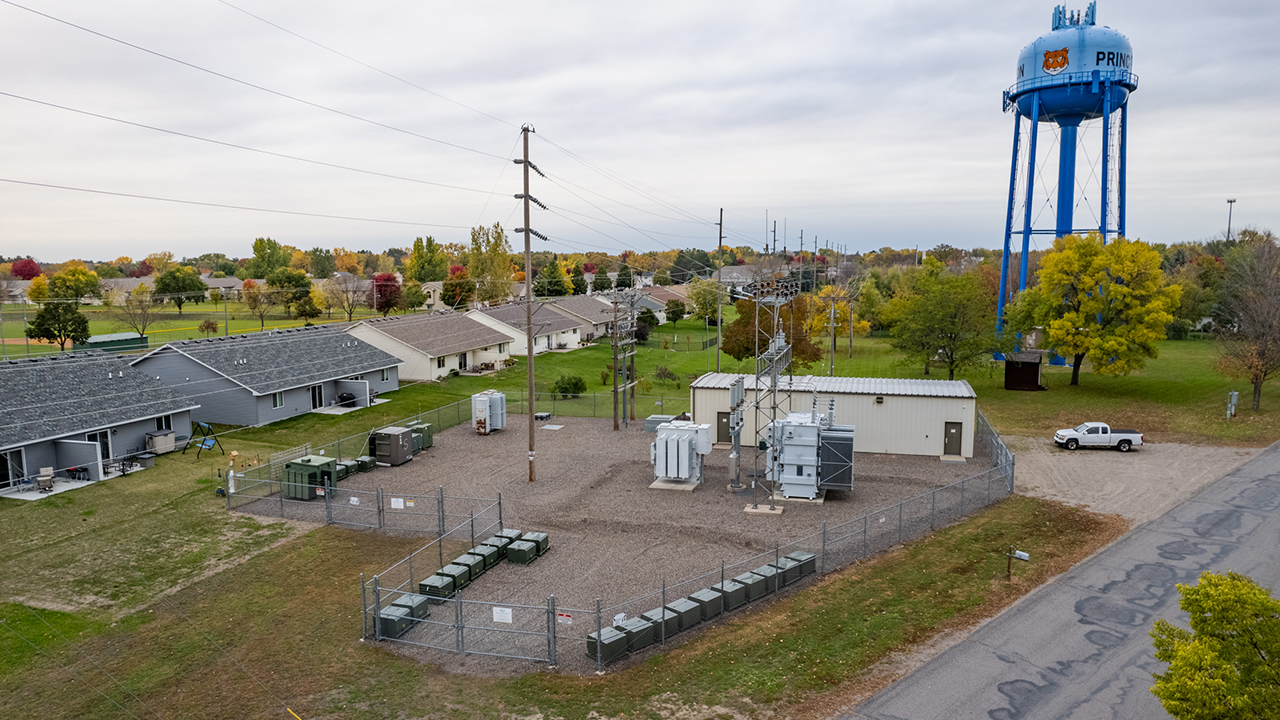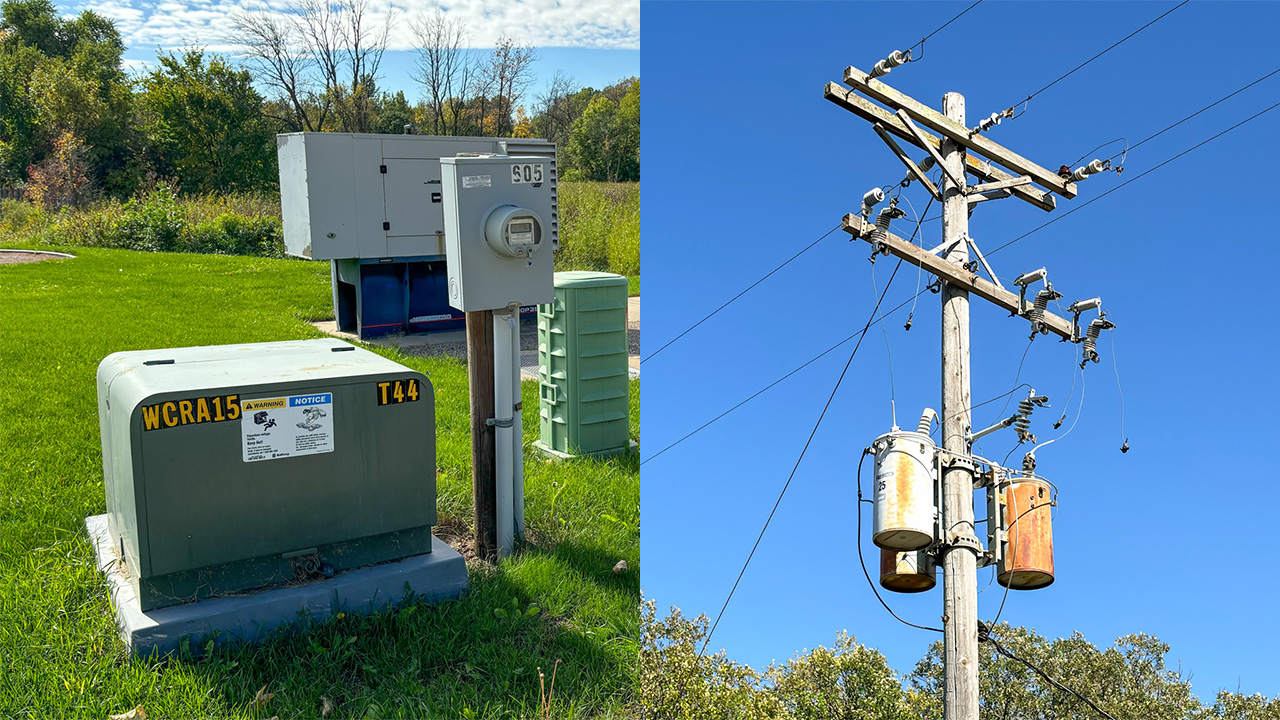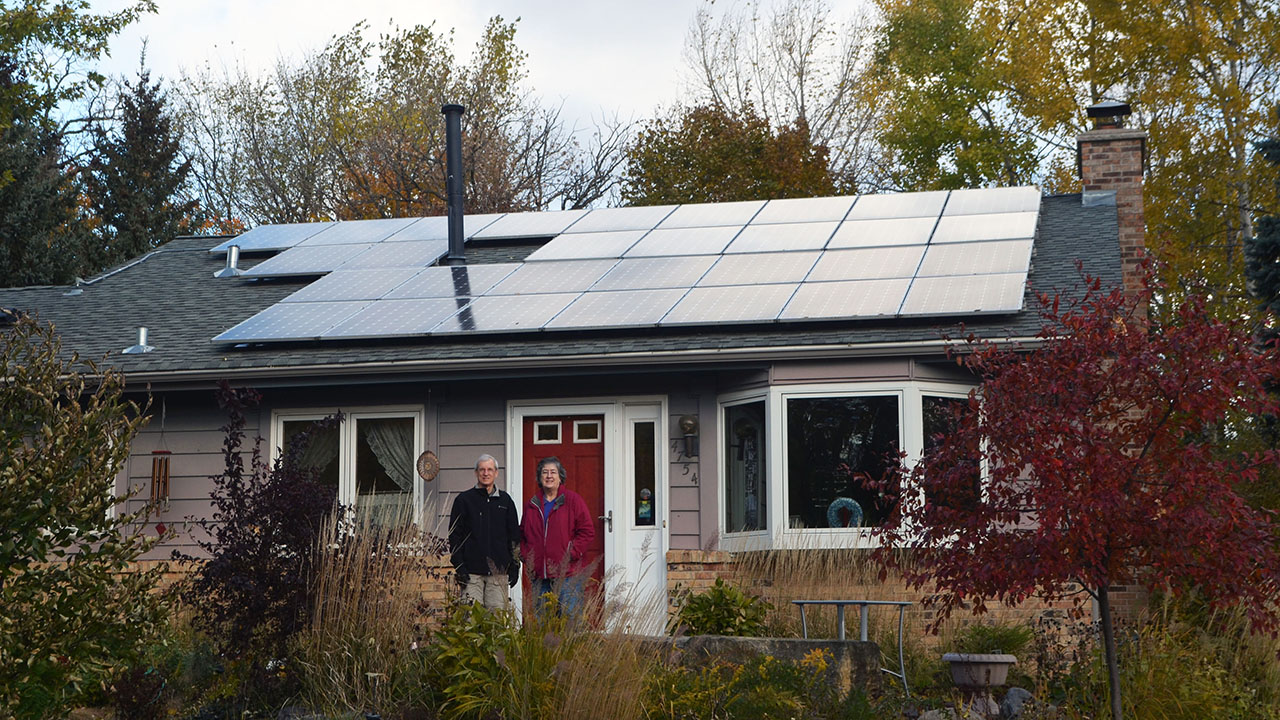
In a nutshell:
– The electrical distribution system is the “poles and wires” infrastructure that carries electricity through our neighborhoods. It’s a more local, lower-voltage system than the transmission system that carries electricity over longer distances.
– Today’s distribution system must be upgraded to meet our changing needs: accommodating rooftop and community solar, powering new loads like electric vehicle chargers and electric heat pumps, and allowing new grid modernization technology.
– Fresh Energy advocates at the Minnesota Public Utilities Commission for electric utilities to prepare their distribution system for the energy transition, providing clean power equitably and efficiently.
Fresh Energy is committed to ensuring the Midwest leads from the North with a future-proof electric grid that can handle extreme weather and power our lives as we transition off fossil fuels to carbon-free energy to power our homes and businesses, how we get around, and beyond. Traditionally, the most important aspect of our electric grid was to reliably move electricity from point A to point B. However, the transition to clean electricity is underway, and we need our electric grid to be capable of even more as we “decarbonize” our way of life by transitioning to equipment like electric vehicles, heat pumps, and more.
That’s where the electrical distribution system comes in. You’re likely familiar with it—it’s the poles and wires that probably wind through your neighborhood. But what exactly is the electrical distribution system, and how does it play a crucial role in our decarbonized, clean energy future? Keep reading to find out!
What is the electrical distribution system?
We wrote a great overview of how the electric grid works, but here’s a quick refresher: first, electricity is generated at a wind or solar farm, then a substation “steps up” the voltage to transport the electricity. Next, transmission lines—those really large power lines you often see along highways—carry the electricity over a long distance to where it’s needed. Lastly, a substation “steps down” the voltage near a neighborhood to the local distribution system, the smaller lines that carry electricity through our neighborhoods to our homes and other buildings.
In a nutshell, our grid is split between the electric transmission system, which transports electricity over long distances, and the local distribution system, which carries electricity to homes, businesses, and other consumers.
There are four basic components of the local electrical distribution grid:

Substations – Substations transform high-voltage electricity from the transmission line to low-voltage electricity on the distribution line. This is necessary because while high voltage is an efficient way to move electricity over long distances (sometimes across entire states), in most cases it’s too dangerous for people to safely use high voltage electricity in buildings, so the electricity must be stepped down to a lower voltage. A substation is made of many different components, including air-break switches, oil circuit breakers, step-down transformers, voltage regulators, distribution buses, metal-clad switchgears, and cutout switches.

Distribution lines – Distribution lines are lower voltage wires that carry electricity from substations to your home and neighborhood. They’re smaller lines that cover shorter distances and can be above ground or buried. Their voltages vary, but common sizes are rated to carry 7,200 volts (7.2 kV), 12,470 volts (12.47 kV), and 25,000 volts (25 kV)—about 30 to 100 times higher than your house’s voltage!

Transformers – Transformers perform the final step-down in voltage from the distribution line to a building, typically bringing the voltage down to 240 volts before entering the building’s electric meter for use in homes and businesses. Transformers are usually in a gray cylinder mounted to an electrical pole or a green box mounted on a pad of concrete along a driveway or sidewalk.

Distributed Generation and Battery Storage – A relatively new addition to the local distribution grid is smaller-scale electricity generators like rooftop solar and community solar gardens, as well as distribution-scale battery storage. Distributed solar and storage enhances grid resiliency, reliability, and, in some cases, can be built more quickly and cost-effectively than utility-scale generation and storage.
The electrical distribution system is built and maintained by Minnesota’s investor-owned utilities (IOUs), municipal utilities (called munis), or cooperative utilities (sometimes called rural electric associations). These electric utilities are responsible for making sure you have reliable, cost-effective electricity when you flip a light switch, turn on a coffee pot, or charge your EV. Investor-owned utilities in Minnesota include Minnesota Power, Otter Tail Power, and Xcel Energy, and they are regulated by the Minnesota Public Utilities Commission. Munis are regulated by city councils or locally-appointed utility commissions, and co-ops are typically self-governed by a member-elected board of directors. All three types of electric utilities oversee their local distribution grid and are responsible for maintaining the system (like replacing a distribution line after a tree falls on it during a storm) and planning new investments to add new customers or more power for existing customers, which we’ll get into below.
Turn Awareness Into Action
Our clean energy future needs you. Take the next step and sign up for Powering Progress!
Our monthly e-newsletter keeps you informed, inspired, and ready to take action for a sustainable future.
Sign Up TodayThe distribution system is evolving meet our climate needs—but not fast enough
A key area of Fresh Energy’s advocacy is accelerating the energy transition: transitioning our lives (including how we get around, how we heat and cool our homes, how we cook our food, and beyond) off fossil fuels and onto clean electricity from renewable sources like wind and solar. That means implementing solutions like replacing a gas furnace with an electric heat pump, a traditional internal combustion engine vehicle with an electric vehicle, and a polluting gas-powered lawn mower with a quiet electric mower.
We’ve already written about how Fresh Energy is working to improve transmission system to create a cleaner electricity grid, but we also need to improve our distribution system in three unique ways to support the energy transition:
- Allow more local, distributed energy sources like rooftop solar. The grid of the past was built to accommodate huge, dirty power plants like the 2,200-megawatt Sherco coal plant near Becker, Minnesota, which sends the electricity it generates through transmission lines then distribution lines to power our homes. Thanks to technology advances and cost declines, smaller “distributed energy resources” like rooftop solar have now become popular. These sources of electricity can be built more quickly than traditional power plants and plug right into a neighborhood’s existing distribution system. They can have tremendous benefits for customers, including greater flexibility, reliability, and lower electricity bills—but may require an electric utility to make investments in the local distribution grid before they can come online. These investments are made on the hyper-local level, sometimes requiring utilities to upgrade the distribution system on a certain block where a few homes want to add solar. As the number of distributed energy resources grows, utilities are grappling with new questions about how to plan the grid. These questions are being addressed in Integrated Distribution Plans (more on that below).
- Allow more electricity to reach our homes to power electric vehicles, heat pumps, and more. If you’ve ever decided to add electricity to a garden shed or new garage, you’ve maybe encountered some difficulty in figuring out how to properly power it. Similarly, as people electrify their homes to run their electric vehicle (EV) charger, heat pump, and electric appliances with clean energy, the local distribution grid may need upgrades to provide that extra power. For example, if everyone on your block decided to install an EV charger in their garage, the local electric utility might have to make a few improvements to your (hyper-local) distribution system to accommodate that extra power (what we call “load” in the industry).
- Create a modern “smart grid” for better efficiency and cost. New grid modernization technologies have allowed unprecedented ways of tracking and shifting energy use to make the grid more reliable, efficient, and capable of accessing least-cost electricity. Smart technologies and new software are helping utilities get better, real-time information about what is happening on the grid which can help improve customer service, reliability, and lead to more efficient uses of our grid infrastructure. These tools also unlock new ways for customers to view their energy usage, opt-in to conservation programs, and match their energy usage with clean power. For example, many Minnesota utilities offer programs where customers with an EV can opt-in to overnight charging. Since there’s less demand for electricity overnight while people sleep, the cost is much lower, and there also tends to be an excess of wind power overnight. So, programs like this allow EV customers to charge their vehicle overnight in exchange for a lower electricity cost and a cleaner fuel supply.
As we transition our way of living to run on clean electricity instead of fossil fuels, it will require investments in the local distribution system to handle both new sources of electricity generation, like rooftop solar, and new sources of electricity use, like charging EVs and powering heat pumps. At the same time, much of our existing grid infrastructure is aging and will soon be due for an upgrade. We have an opportunity to make these updates in ways that also advance the energy transition and prepare the grid for the next several decades of change.
How Fresh Energy plugs in to the electrical distribution system
By now, you hopefully have a good idea of how the distribution system works and how it needs to evolve to meet the moment in our decarbonized economy. But how does Fresh Energy fit into all this, you ask? At Fresh Energy, our policy experts are working to ensure the entire state of Minnesota is building a future-proof distribution grid that can handle extreme weather, new sources of clean electricity, a growing electricity demand to power our decarbonized lives, and new, more flexible technology. To do this, Fresh Energy advocates at the Minnesota Public Utilities Commission (PUC, or Commission) for smart, effective distribution planning.
Fresh Energy engages in investor-owned electric utilities’ Integrated Distribution Plans (IDPs), which are planning documents utilities file with the Commission every two years laying out how they plan to meet distribution needs and what this will cost customers over the next five years. We file comments and provide expert testimony that encourages utilities to upgrade the distribution grid to accelerate the energy transition while balancing energy access, equity, and justice. Fresh Energy will be engaging in the 2023 IDPs at the Commission later this year.
Fresh Energy also engages in rate cases at the Commission, the regulatory processes that set the rates a utility is allowed to charge customers (also called ratepayers in the utility world). We often advocate for policies, rates, and programs that promote increased access to clean, renewable energy for all Minnesotans, especially under-resourced communities, at prices that are affordable and reasonable to everyone who calls our state home. More specifically, we advocate against fixed charges that disincentivize conservation and are disproportionately unfair to financially under-resourced customers and advocate for programs like demand response and time-of-use rates to increase the flexibility of customers’ electricity demand, which has benefits for system reliability, efficiency, and renewable power generation.
Next, Fresh Energy participates in Xcel Energy’s hosting capacity process, in which Xcel evaluates and maps each segment of the Minnesota distribution grid for its ability to host new solar energy without requiring any equipment changes. Such “no regrets” planning tools can help clean power come online quickly and cost-effectively, all thanks to smart planning and policy.
Lastly, Fresh Energy closely tracks the interconnection process, which distributed energy resources, like rooftop solar or on-site batteries, must go through to connect to the grid. Fresh Energy played an integral role in updating the state’s interconnection guidelines from 2016-2020, and we continue to track implementation of the new standards and work with utilities, clean energy developers and others to solve emerging challenges. Most recently, Fresh Energy developed a cost-sharing program for small projects (like rooftop solar) in Xcel territory, which was approved by the PUC in 2022, and worked with state legislators to pass several pieces of legislation in 2023 designed to improve grid planning and help residents seeking to install solar or storage in grid-constrained areas.
What’s next?
Fresh Energy is excited to continue working with stakeholders across the climate and energy field to advance proactive, holistic electric distribution system planning to accommodate more clean electricity, unlock new carbon-free ways of powering our lives, and making the most of new smart grid technologies to enhance efficiency and reliability. Stay tuned as we dig into the 2023 IDPs later this year!

